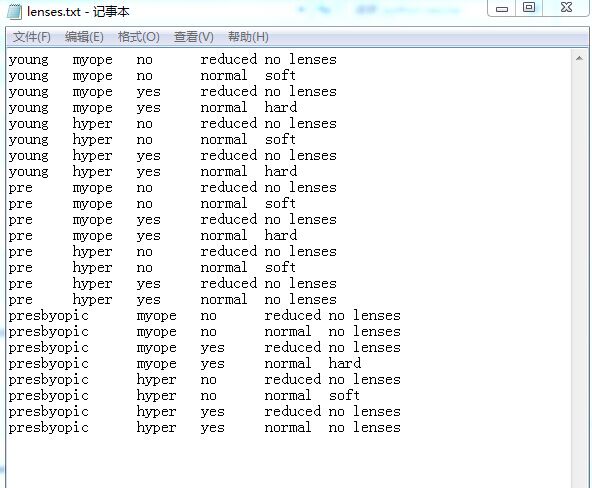【Machine Learning in Action --3】决策树ID3算法预测隐形眼睛类型
本节讲解如何预测患者需要佩戴的隐形眼镜类型。
1、使用决策树预测隐形眼镜类型的一般流程
(1)收集数据:提供的文本文件(数据来源于UCI数据库)
(2)准备数据:解析tab键分隔的数据行
(3)分析数据:快速检查数据,确保正确地解析数据内容,使用createPlot()函数绘制最终的树形图
(4)训练算法:createTree()函数
(5)测试算法:编写测试函数验证决策树可以正确分类给定的数据实例
(6)使用算法:存储数的数据结构,以使下次使用时无需重新构造树
trees.py如下:
#!/usr/bin/python
# -*- coding: utf-8 -*-
from math import log
#计算给定数据集的香农熵
def calcShannonEnt(dataSet):
numEntries=len(dataSet)
labelCounts={}
for featVec in dataSet:
currentLabel=featVec[-1]
if currentLabel not in labelCounts.keys():
labelCounts[currentLabel]=0
labelCounts[currentLabel]+=1
shannonEnt=0.0
for key in labelCounts:
prob=float(labelCounts[key])/numEntries
shannonEnt -=prob*log(prob,2)
return shannonEnt
#按照给定特征划分数据集
def splitDataSet(dataSet,axis,value):
retDataSet=[]
for featVec in dataSet:
if featVec[axis]==value:
reducedFeatVec=featVec[:axis]
reducedFeatVec.extend(featVec[axis+1:])
retDataSet.append(reducedFeatVec)
return retDataSet
#选择最好的数据集划分方式
def chooseBestFeatureToSplit(dataSet):
numFeatures=len(dataSet[0])-1
baseEntropy=calcShannonEnt(dataSet) #计算整个数据集的原始香农熵
bestInfoGain=0.0;bestFeature=-1
for i in range(numFeatures): #循环遍历数据集中的所有特征
featList=[example[i] for example in dataSet]
uniqueVals=set(featList)
newEntropy=0.0
for value in uniqueVals:
subDataSet=splitDataSet(dataSet,i,value)
prob=len(subDataSet)/float(len(dataSet))
newEntropy+=prob*calcShannonEnt(subDataSet)
infoGain=baseEntropy-newEntropy
if(infoGain>bestInfoGain):
bestInfoGain=infoGain
bestFeature=i
return bestFeature
def majorityCnt(classList):
classCount={}
for vote in classList:
if vote not in classCount.keys():classCount[vote]=0
classCount[vote]+=1
sortedClassCount=sorted(classCount.iteritems(),key=operator.itemgetter(1),reverse=True)
return sortedClassCount[0][0]
#创建树的函数代码
def createTree(dataSet,labels):
classList=[example[-1] for example in dataSet]
if classList.count(classList[0])==len(classList): #类别完全相同规则停止继续划分
return classList[0]
if len(dataSet[0])==1: return majorityCnt(classList)
bestFeat=chooseBestFeatureToSplit(dataSet)
bestFeatLabel=labels[bestFeat]
myTree={bestFeatLabel:{}}
del(labels[bestFeat]) #得到列表包含的所有属性
featValues=[example[bestFeat] for example in dataSet]
uniqueVals=set(featValues)
for value in uniqueVals:
subLabels=labels[:]
myTree[bestFeatLabel][value]=createTree(splitDataSet(dataSet,bestFeat,value),subLabels)
return myTree
#测试算法:使用决策树执行分类
def classify(inputTree,featLabels,testVec):
firstStr=inputTree.keys()[0]
secondDict=inputTree[firstStr]
featIndex=featLabels.index(firstStr)
for key in secondDict.keys():
if testVec[featIndex]==key:
if type(secondDict[key]).__name__=='dict':
classLabel=classify(secondDict[key],featLabels,testVec)
else:classLabel=secondDict[key]
return classLabel
#使用算法:决策树的存储
def storeTree(inputTree,filename):
import pickle
fw=open(filename,'w')
pickle.dump(inputTree,fw)
fw.close() def grabTree(filename):
import pickle
fr=open(filename)
return pickle.load(fr)
treePlotter.py如下:
#!/usr/bin/python
# -*- coding: utf-8 -*-
import matplotlib.pyplot as plt
from numpy import *
import operator
#定义文本框和箭头格式
decisionNode=dict(boxstyle="sawtooth",fc="0.8")
leafNode=dict(boxstyle="round4",fc="0.8")
arrow_args=dict(arrowstyle="<-")
#绘制箭头的注解
def plotNode(nodeTxt,centerPt,parentPt,nodeType):
createPlot.ax1.annotate(nodeTxt,xy=parentPt,xycoords='axes fraction',xytext=centerPt,textcoords='axes fraction',va="center",ha="center",bbox=nodeType,arrowprops=arrow_args)
def createPlot():
fig=plt.figure(1,facecolor='white')
fig.clf()
createPlot.ax1=plt.subplot(111,frameon=False)
plotNode(U'决策节点',(0.5,0.1),(0.1,0.5),decisionNode)
plotNode(U'叶节点',(0.8,0.1),(0.3,0.8),leafNode)
plt.show()
#获取叶节点的数目和树的层数
def getNumLeafs(myTree):
numLeafs=0
firstStr=myTree.keys()[0]
secondDict=myTree[firstStr]
for key in secondDict.keys():
if type(secondDict[key]).__name__=='dict':
numLeafs += getNumLeafs(secondDict[key])
else: numLeafs +=1
return numLeafs
def getTreeDepth(myTree):
maxDepth=0
firstStr=myTree.keys()[0]
secondDict=myTree[firstStr]
for key in secondDict.keys():
if type(secondDict[key]).__name__=='dict':
thisDepth=1+getTreeDepth(secondDict[key])
else:thisDepth=1
if thisDepth>maxDepth:maxDepth=thisDepth
return maxDepth def retrieveTree(i):
listOfTrees=[{'no surfacing':{0:'no',1:{'flippers':{0:'no',1:'yes'}}}},\
{'no surfacing':{0:'no',1:{'flippers':{0:{'head':{0:'no',1:'yes'}},1:'no'}}}}]
return listOfTrees[i]
#在父节点间填充文本信息
def plotMidText(cntrPt,parentPt,txtString):
xMid=(parentPt[0]-cntrPt[0])/2.0+cntrPt[0]
yMid=(parentPt[1]-cntrPt[1])/2.0+cntrPt[1]
createPlot.ax1.text(xMid,yMid,txtString)
#计算宽和高
def plotTree(myTree,parentPt,nodeTxt):
numLeafs=getNumLeafs(myTree)
depth=getTreeDepth(myTree)
firstStr=myTree.keys()[0]
cntrPt=(plotTree.xOff+(1.0+float(numLeafs))/2.0/plotTree.totalW,plotTree.yOff)
plotMidText(cntrPt,parentPt,nodeTxt) #计算父节点和子节点的中间位置
plotNode(firstStr,cntrPt,parentPt,decisionNode)
secondDict=myTree[firstStr]
plotTree.yOff=plotTree.yOff-1.0/plotTree.totalD
for key in secondDict.keys():
if type(secondDict[key]).__name__=='dict':
plotTree(secondDict[key],cntrPt,str(key))
else:
plotTree.xOff=plotTree.xOff+1.0/plotTree.totalW
plotNode(secondDict[key],(plotTree.xOff,plotTree.yOff),cntrPt,leafNode)
plotMidText((plotTree.xOff,plotTree.yOff),cntrPt,str(key))
plotTree.yOff=plotTree.yOff+1.0/plotTree.totalD
def createPlot(inTree):
fig=plt.figure(1,facecolor='white')
fig.clf()
axprops=dict(xticks=[],yticks=[])
createPlot.ax1=plt.subplot(111,frameon=False,**axprops)
plotTree.totalW=float(getNumLeafs(inTree))
plotTree.totalD=float(getTreeDepth(inTree))
plotTree.xOff=-0.5/plotTree.totalW;plotTree.yOff=1.0;
plotTree(inTree,(0.5,1.0),'')
plt.show()
lenses.txt如下:

运行如下:
>>> import trees
>>> import treePlotter
>>> fr=open('lenses.txt')
>>> lenses=[inst.strip().split('\t') for inst in fr.readlines()]
>>> lensesLabels=['age','prescript','astigmatic','tearRate']
>>> lensesTree=trees.createTree(lenses,lensesLabels)
>>> lensesTree
{'tearRate': {'reduced': 'no lenses', 'normal': {'astigmatic': {'yes': {'prescript': {'hyper': {'age': {'pre': 'no lenses', 'presbyopic': 'no lenses', 'young': 'hard'}}, 'myope': 'hard'}}, 'no': {'age': {'pre': 'soft', 'presbyopic': {'prescript': {'hyper': 'soft', 'myope': 'no lenses'}}, 'young': 'soft'}}}}}}
>>> treePlotter.createPlot(lensesTree)
由图看出决策树非常好地匹配了实验数据,然而这些匹配选项可能太多。我们将这种问题称之为过度匹配(overfitting)。为了减少过度匹配问题,我们可以裁剪决策树,去掉一些不必要的叶子节点。如果叶子节点只能增加少许信息,则可以删除该节点,将它并入到其他叶子节点中。
【Machine Learning in Action --3】决策树ID3算法预测隐形眼睛类型的更多相关文章
- 机器学习实战(Machine Learning in Action)学习笔记————03.决策树原理、源码解析及测试
机器学习实战(Machine Learning in Action)学习笔记————03.决策树原理.源码解析及测试 关键字:决策树.python.源码解析.测试作者:米仓山下时间:2018-10-2 ...
- 《Machine Learning in Action》—— Taoye给你讲讲决策树到底是支什么“鬼”
<Machine Learning in Action>-- Taoye给你讲讲决策树到底是支什么"鬼" 前面我们已经详细讲解了线性SVM以及SMO的初步优化过程,具体 ...
- 《Machine Learning in Action》—— 小朋友,快来玩啊,决策树呦
<Machine Learning in Action>-- 小朋友,快来玩啊,决策树呦 在上篇文章中,<Machine Learning in Action>-- Taoye ...
- 机器学习实战(Machine Learning in Action)学习笔记————08.使用FPgrowth算法来高效发现频繁项集
机器学习实战(Machine Learning in Action)学习笔记————08.使用FPgrowth算法来高效发现频繁项集 关键字:FPgrowth.频繁项集.条件FP树.非监督学习作者:米 ...
- 机器学习实战(Machine Learning in Action)学习笔记————07.使用Apriori算法进行关联分析
机器学习实战(Machine Learning in Action)学习笔记————07.使用Apriori算法进行关联分析 关键字:Apriori.关联规则挖掘.频繁项集作者:米仓山下时间:2018 ...
- 机器学习实战(Machine Learning in Action)学习笔记————06.k-均值聚类算法(kMeans)学习笔记
机器学习实战(Machine Learning in Action)学习笔记————06.k-均值聚类算法(kMeans)学习笔记 关键字:k-均值.kMeans.聚类.非监督学习作者:米仓山下时间: ...
- 机器学习实战(Machine Learning in Action)学习笔记————02.k-邻近算法(KNN)
机器学习实战(Machine Learning in Action)学习笔记————02.k-邻近算法(KNN) 关键字:邻近算法(kNN: k Nearest Neighbors).python.源 ...
- Machine Learning in Action(5) SVM算法
做机器学习的一定对支持向量机(support vector machine-SVM)颇为熟悉,因为在深度学习出现之前,SVM一直霸占着机器学习老大哥的位子.他的理论很优美,各种变种改进版本也很多,比如 ...
- Machine Learning In Action 第二章学习笔记: kNN算法
本文主要记录<Machine Learning In Action>中第二章的内容.书中以两个具体实例来介绍kNN(k nearest neighbors),分别是: 约会对象预测 手写数 ...
随机推荐
- Servlet源码初探
年底,公司的事情告一段落,就来捣鼓一下这个Servlet源码,为下一步的spingmvc源码初探做准备 1.Servlet接口 public interface Servlet { void init ...
- gmic全球移动互联网大会 全球九站已开启!
由长城会主办的全球移动互联网大会( 简称GMIC)已成长为世界范围内最具影响力的辐射并连结东西半球的移动互联网商务平台,是最大规模的移动互联网行业盛会. 2017gmic全球移动互联网大会北京站将于2 ...
- VR应用向导,全球Top10 VR应用排行榜
2016年国际知名产商索尼.三星.HTC.Oculus.YouTube等等都推出了自己的VR设备,与此同时还有自有的VR应用平台,供各位玩家下载应用体验沉浸式VR,当然每个平台的VR应用下载量各不相同 ...
- [Q]自定义保存位置及文件名
以“DWG To PDF.pc3”打印为例: 说明:<DrawingDirectory> 当前图纸所在目录<DrawingFolderName> 当前图纸文件所在文件夹名称&l ...
- 一个JQuery发送ajax请求
环境: 1.jQuery v2.1.1 2.ThinkPHP 3.2.3 HTML页面: <button type="button" id="cat" o ...
- cxf 报错:java.lang.NoSuchMethodError: org.apache.ws.commons.schema.XmlSchemaCollection.read(Lorg/w3c/dom/Document;Ljava/lang/String;)
由于没有仔细查看官方提供的文档,由jdk版本不一致导致的出错: http://cxf.apache.org/cxf-316-release-notes.html 自己使用的是jdk1.8. 报Exce ...
- Intellij IDEA下导出Java工程的可运行JAR包
Intellij IDEA下导出Java工程的可运行JAR包 昨天一直向导出一个Java工程的可运行JAR包,然后查阅网上的资料以及自己一遍一遍的尝试,均以失败告终.可以导出JAR包,但是导出的JAR ...
- ARM驱动调试方法、思路总结、笔记
驱动程序的调试一. 打印: prink, 自制proc文件UBOOT传入console=ttySAC0 console=tty11. 内核处理UBOOT传入的参数console_setup add_p ...
- openstack私有云布署实践【4.1 上层代理haproxy配置 (科兴环境)】
官方文档上的高可用配置,它推荐的是使用haproxy的上层代理来实现服务组件的主备访问.或者负载均衡访问 一开始我也是使用haproxy来做的,但后来方式改了 测试环境:haproxy + n ...
- CentOS6.3配置SVN之subversion1.7.7
今天配置了 SVN 记在这儿 备忘: 1. 下载 svn 软件包和依赖包 cd /mydata/soft wget http://labs.mop.com/apache-mirror/subversi ...

